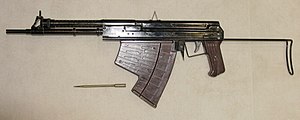APS amphibious rifle
| APS | |
|---|---|

APS underwater rifle with 5.66-mm cartridge
|
|
| Type | Underwater Assault rifle |
| Place of origin | Soviet Union |
| Service history | |
| In service | 1975 |
| Used by | Russia |
| Production history | |
| Designer | Vladimir Simonov |
| Designed | 1970s |
| Manufacturer |
Tula Arms Plant, |
| Produced | 1975–present |
| Specifications | |
| Weight | 3.0 kg empty 3.9 kg loaded |
| Length | 840 mm with stock extended 620 mm with stock retracted |
| Barrel length | 300 mm |
| Width | 65 mm |
|
|
|
| Cartridge | 5.66×39mm MPS and tracer MPST |
| Caliber | 5.66mm |
| Action | Gas actuated |
| Rate of fire | 600 rounds per minute (in air) |
| Muzzle velocity | 340–360 meter per second (in air) |
| Effective firing range | 30 m at depth 5 m (98 ft at depth 16 ft) 20 m at depth 20 m (66 ft at depth 66 ft) 11 m at depth 40 m (36 ft at depth 131 ft) |
| Maximum firing range | 100 m in the air |
| Feed system | 26-round detachable Magazine |
The APS underwater assault rifle (APS stands for Avtomat Podvodny Spetsialnyy (Автомат Подводный Специальный) or "Special Underwater Assault Rifle") is an underwater firearm designed by the Soviet Union in the early 1970s. It was adopted in 1975. Made by the Tula Arms Plant (Тульский Оружейный Завод, Tul'skiy Oruzheynyy Zavod) in Russia, it is exported by Rosoboronexport.
Underwater, ordinary-shaped bullets are inaccurate and have a very short-range. The APS fires a 120 mm (4.75 in) long 5.66 mm calibre steel bolt (specially designed for this rifle and has been mistaken as 5.56 mm). Its magazine holds 26 cartridges. The APS's barrel is not rifled; the fired projectile is kept in line by hydrodynamic effects; as a result, the APS is somewhat inaccurate when fired out of water.
The APS has a longer range and more penetrating power than spearguns. This is useful in such situations as shooting an opposing diver through a reinforced dry suit, or a protective helmet (whether air-holding or not), thick tough parts of breathing sets and their harnesses, and plastic casings and transparent covers of some small underwater vehicles.
The APS is more powerful than a pistol, but is bulkier and takes longer to aim, particularly swinging its long barrel and big flat magazine sideways through water.
The rising threat of attacks by frogmen in naval bases caused various anti-frogman techniques to be developed, and in the USSR one of these was guard frogmen sent to stop the attackers. At first these guard frogmen were armed only with knives and AK-type rifles. The AK-47 was carried in a waterproof case and could only be used on the surface, so the only effective underwater weapon against enemy frogmen was the knife.
...
Wikipedia
